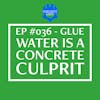EP #078: The Role of ASTM in Concrete and Flooring - A Comedy of Errors
In this episode, Seth interviews Jim Kaylor from Durability Consultants about ASTM F6 and ASTM F710. They discuss the role of ASTM in the construction industry and the slow process of developing standards. They also delve into the issue of moisture in resilient flooring and the limitations of ASTM F710.
Jim shares his insights on proposed changes to the standard and emphasizes the importance of collaboration and coordination between different stakeholders. They conclude by highlighting the significance of good concrete and flooring practices and exploring alternative solutions such as polishing and enhancing concrete.
Takeaways
- ASTM plays a crucial role in the construction industry by developing standards for various materials and practices.
- The process of developing ASTM standards is slow and involves collaboration between different stakeholders.
- Moisture is a significant issue in resilient flooring, and ASTM F710 provides guidelines for addressing this problem.
- There is a need for improvements in ASTM F710 to address the complexities of flooring installation and ensure successful outcomes.
- Good concrete and flooring practices, as well as coordination between different trades, are essential for avoiding flooring failures.
Chapters
00:00 Introduction and Ways to Support the Podcast
03:32 Introduction to ASTM and its Importance
07:41 The Role of Committees and the Slow Process of ASTM
12:20 The Issue of Moisture in Resilient Flooring
18:45 The Limitations of ASTM F710
23:39 The Need for Collaboration and Coordination
30:04 Proposed Changes to ASTM F710
36:21 Addressing the Whole Flooring Process
41:31 The Importance of Good Concrete and Flooring Practices
46:12 Alternative Solutions: Polishing and Enhancing Concrete
47:20 Conclusion and Contact Information
***
Did you learn something from this episode? If so, please consider donating to the show to help us continue to provide high-quality content for the concrete industry.
Donate here: https://www.concretelogicpodcast.com/support/
***
Episode References
Guest: Jim Kaylor | Durability Consultants | jim@durabilityconsultants.com
Guest Website: https://durabilityconsultants.com
Producers: Jodi Tandett, Jace Stocker
Donate & Become a Producer: https://www.concretelogicpodcast.com/support/
Music: Mike Dunton | https://www.mikeduntonmusic.com | mikeduntonmusic@gmail.com | Instagram @Mike_Dunton
Host: Seth Tandett, seth@concretelogicpodcast.com
Host LinkedIn: https://www.linkedin.com/in/seth-tandett/
Website: https://www.concretelogicpodcast.com/
LinkedIn: https://www.linkedin.com/company/concrete-logic-podcast
[00:00:00] Seth: Welcome to another episode of the Concrete Logic Podcast. And today I have Jim Koehler with Durability Consultants with me, and we're going to discuss ASTM F6, which is the Committee on Resilient Floor Coverings and ASTM F710, the Standard Practice for Preparing Concrete Floors Receive to Receive Resilient Flooring.
So Jim's going to help me understand what those. Two things are and help you all understand as well, but before I get started, my favorite part of the podcast recently is getting you guys to understand how the podcast works and how you can support the show. So there are three ways you can support the show.
One is please, if you get some kind of value out of this, don't be selfish. Share this podcast episode with. One of your colleagues or a coworker. The second way you can help out is if you go to ConcreteLogicPodcast.com, there's a couple of ways you can reach out to me. You can hit contact, which will email me, or there's a little microphone at the bottom right hand side of the page.
You can leave me a voicemail that way. And what I'm looking for help with is ideas for topics or guests. So most of the folks that are on this podcast or suggestions from listeners or past guests that say, hey, you should talk to, so and so, hey, you should talk to Jim Kaler, or you should cover, concrete moisture.
Things like that, that you all want to learn about. Please reach out and let me know what you want. Want to hear on the show because this podcast is for you all. And then the last thing you can do is you can on the same homepage of concrete logic, podcast. com in the upper right hand corner, there's a donate button and that donation button is there is for folks.
If you get some kind of value out of this show and you want to give to the show, you can click on that and give any dollar amount and any dollar amount is. Just any amount is good enough for me. It does whatever you get out of the show. Be a dollar, 5, 500, whatever it is feel free to do that.
And you're probably like, Seth, that's a crazy idea. Sounds novel. Well, it's not, I stole it from somebody else. And I'm going to give them a shout out. I was wondering at what point I was going to give these people a shout out, but if y'all You should check out no agenda podcast. It's got Adam Curry and John C.
Dvorak on there, and they've been doing this value for value model where of their listeners donate to their show for the last 16 years. So this is not something new. I didn't make this up. This really works. So, check it out. And then with that Jim let's dive right into F6. And F710, which are ASTM, what are they?
Can you explain it? Maybe we should start off with what the heck is ASTM and why should we care about ASTM?
[00:03:16] Jim Kaylor: Good question. Yeah, ASTM, American Standards Testing and Materials.
God, how do you wrap up ASTM, huh? That's interesting. I guess everything that we make in the construction industry at some point goes through ASTM. I know like when you go and do yard work, you get the plastic PVC piping from Home Depot, and it'll have an ASTM on there, so. I don't know, I hate to say like everything's certified because that's maybe not super accurate, but an overriding governing body over just about every construction material, I would think.
I think that's safe. I sit on a number of the ASTM's CO9 concrete and aggregates, DO8 is waterproofing, D30 is composites, GFRP bar I have an interest in, EO6 is overall Building science, building health, if you will. F6, as you mentioned, is the fluorine group, and then G01 is corrosion. And those are the groups that I, like I said, I think I'm at least a voting member on at least one committee, but again, for me, it's a little ADD-ish, it's more of, I don't want to be the guy that has the expertise necessarily to guide it, but in my industry, I want to know where it's going before it goes there. So, I'm like the voyeur. I'm there. But I'm not there. I, have an opinion on certain things. I know I have a pretty good background in concrete and cement chemistry.
But beyond that if you're talking about waterproof membranes, I almost always abstain in my votes, unless you're an expert in that field. I feel you should like me, stand back and watch the work reports that are done. When something doesn't just happen there's reports that are drafted by committees.
They go back and forth. They vote on it. There's negatives. It's a whole process. Then they sit down and it's mind numbing. They go over the English language and convention of a's and they's and you go through that whole thing. And then a report is published. And these things do not move quickly.
They move like glaciers do. But, there's some method to that madness, too. Our industry is very old, very conservative. You don't want some newfangled thing coming down the pike. Everybody jumps on board. So the ship moves very slowly. But I think that's Probably a good thing, too. So, yeah, I sit on a number of committees.
Again, I don't give the impression like I'm driving the boat, but I'm more just a passenger. I'm just watching. I'll give you an example, I think. Again, I talk about some of the monotony involved in it a few years ago. The fly ash guys. There's no secret. Particularly here on the west coast. Fly ash is running out.
We've done an excellent job, if you will, of taking the fly ash, the product of burning coal, and burying it in our concrete. Now with that said, there's a lot of benefits to the concrete. Pozzolanic activity, it tightens it, densifies it, probably makes it more durable, obviously more sustainable. But we don't have much of it.
So now they want to go and broaden the definition. They want to take the bottom ash and the middle part of it. I don't want to be hyper dramatic, but I mean it almost breaks into fistfights in the back of these committee meetings and stuff. And that's about as exciting as it gets, so. Yeah. It's a very slow moving.
So I just want to paint the picture here. What we're dealing with, the animal.
[00:07:05] Seth: what type of folks are on these committees?
[00:07:08] Jim Kaylor: You have a little bit of everything, obviously. I'm a consultant, but again, that's just a fancy way. I'm a peddler. I'm a salesman.
So you have people like me would be like distributors or manufacturer representatives, and then you have a whole engineering community. You get a lot of folks from the universities, the colleges. We're doing primary research. And again, these are the guys that usually have P. E. after their name. S. E. P. H. D. Wear blue blazers and are overall pretty sharp guys. Yeah. So it's a conglomeration. Contractors, suppliers designers, specifiers in the engineering community. So it's eclectic to say the least.
[00:07:51] Seth: And this ASTM F6 committee, they just cover resilient floor coverings. Is that correct?
[00:08:00] Jim Kaylor: Yes, yeah. The back story is such, the greening of the planet, if you will. Back in the late 90s there's no secret. They outlawed paints and solvent based oil based products. It's, before I was old and fat, I used to race a bicycle around. I rode a bicycle quite a bit.
We used to paint our bikes. And then after a while, almost overnight, you'd set your bike, and you'd get it scratched. So, we all moved over, and we get our stuff powder coated now. But that's no secret. They just took out all the solvents, the heavy VOCs, and the paints almost overnight deteriorated. Well, that didn't just happen with the paints.
That happened with coatings, adhesives, varnishes, all kinds of stuff. So now you have all of your resilient flooring something that's allergen, hyper allergenic very high hygiene in hospitals, universities. Stuff like that. They don't really breathe well, so now you take your adhesive, they go from a solvent oil based to a water based almost overnight.
So this is probably, what, maybe 98, 99. They did an outlaw, that's not technically correct, but they basically made, if you did continue oil based, The registration, the process, the hoops you had to jump through were so intense that for all practical purposes they forced it out. So now all of your adhesive for your floor companies, big flooring companies, overnight goes to a water base, 50 60 percent in some instances.
So then we ran into a whole issue where you took, you’re concrete, you're building your building, and you have your construction cycle, and obviously, if you've got to be around a superintendent for 10 minutes, and you know everything's late, and should have been in yesterday. So you have a very abbreviated construction schedule, and they go to put their floor on, and these adhesives aren't the same.
You should be able to take what they call cutbacks. This was vicious stuff. You could open a container, like across the street from where you live, and you would smell this. Your eyes with water curl your toes, but the beauty of it was you could stick vinyl to steel under water This stuff was amazing.
Now. There's probably some health benefits, and I don't mean to minimize that Talking about some pretty strong stuff, but that all sudden disappears, and you have an oil based adhesive or excuse me a water based adhesive There's all kinds of problems. Floors blistered, they peeled off, moisture came up through the concrete, either from the concrete itself, in some instances, or from the sub base, Mother Earth, the whole thing, and it would, I want to say, re emulsified, whether the glue actually set Went back into liquid form, gets very technical, but it re emulsifies, and then these floors come up, and got into, by about 2001, 2002, there were some serious issues around the world, not just in this country.
So, that's where the F6 committee, I think, was always there. That is, the resilient flooring, as you said. But that really what launched them into the spotlight saying, okay guys, we're into billions of dollars. I know a guy who works for Forbo, a beautiful foreign company. He was a master mechanic.
They put him on a jet. He would fly all over the planet and go, yep, your floor's coming up. You've got a problem. But it took a while to figure out what that problem was. The moisture. Was it from the concrete? Was it coming through the sub base? The sub base, you had folks like what you call a class A vapor.
Retarder, vapor barrier retarder, you get into that hole. dialogue. But that takes the play, properly installed, that takes the play out of all the moisture coming up from Mother Earth. So then you have moisture within the concrete, and they look to F6. My critique has been rather harsh at times, but I don't know if the F6 initial concern was to fix the problem.
Or was there more of a cottage industry that developed that made a lot of money from diagnosing the problem? That is, you could go hire any of those guys on there, and fly them out, and pay them heavy expenses, and they would look and say, yeah, your floor's coming up, you have a problem. That's nice, you and I both know, say you're not fixing anything, and you write a whole report on what you could have done, what you should have done, what you think the problem was. And again, I want to be very fair. It took a while. Nobody really knew for a while, for a few years. Today, it's easy to look back, right?
Everybody knows how San Francisco should have played the last Super Bowl. We're all experts at that, right? They just played the Super Bowl, but it took a while, but they let it go on for years and years where there was guys that this cottage industry of consultants. Just basically show up and say, yeah, you've got a problem.
That's moisture. It could be coming from A, B, C, or D. That, I think I've been critical of. I think it's a fair criticism. And then you mentioned F 710. And you can read that document if you've got it pulled up. But that's really what they, the product of them going, okay, you guys are in charge at the ASTM level of flooring, resilient flooring and coatings.
You've got to put terrazzo, you got to put some of the high traffic area coatings, epoxies in there. Roofing kind of falls under that universe too. And then they come up with the F 710 document, which is a guidebook, and it says, okay, if you do this, then the assumption is that you will have a successful floor, flooring installation, in years of perfect service.
I again was very critical. There's a section in there that says you shall test for moisture. Now, you use the word shall, I think that's pretty beaten out in the courts. That means it's mandatory. That it's, you have to do it. Well, if I tell you, you have to do this, Seth, you have a reasonable feeling expectation that if you do it, you'll be successful, and that's when you get into in situ relative humidity. The Wagner meters came out very popular. Drill a hole, you're into the top third of the concrete, you let it reach some type of equilibrium, you put a probe in there, and you get a percentage. 75 percent.
That was the kind of, I don't know, almost like a holy Scripture coming down from the mountain first of all, 75 percent is not realistic. If you talk to the gurus, the pros, right? The Tyler lays, Jason Weiss, David Trejo. We mentioned my three heroes. Usually between about 85 to 80 percent, and even below 80 percent, all the really cool magic and concrete ceases.
There's just not enough moisture. It doesn't produce more cement product. It's a good thing, that's what you want, right? Concrete gets harder, it gets stronger. It densifies, it's less permeable. All the good stuff that we want. So to say that, 75%, you have to hit that. I, in my career, probably, what, 15 years now, going on 16 years I've seen a lot of floors that have failed, that had reached that 75%.
And again, these are moving targets. First of all, when you build a project, most of the time, these areas are not acclimated. You don't have the skin on the doors, the windows, the walls, everything. The HVAC is on where you can keep a controlled environment. So to say that, cause you went yesterday morning or yesterday afternoon and you got 75 percent and then I sent a team in this morning to put the floor on. Goodness, there was massive failures. It just didn't work. And it would be the same thing with the calcium chloride. That was one of the other two tests, right? You, properly done, that's a huge statement. You grind, you open up the capillaries on the surface of the concrete.
I don't know if I've ever seen that done. You put a little Petri dish, sodium excuse me, sodium Calcium hydroxide, excuse me, no. Gosh, where are the old Petri dish, yeah, where they weigh the material, you put it on the concrete. And it pulls the moisture up, then you weigh it, and you get that difference.
That is pounds per square foot per 24 hours, per thousand square feet. And you get a number, three pounds. That's the whole that, that's the, again, handed down from the mountain. I've seen a lot of floors fail that were at some point on the surface, three pounds. For 24 hours per thousand square feet.
Again, depending on when you did that, what part of the slab, there's all kinds of factors. And these floors failed. My critique of the F6 folks is that I don't think even to this day that they've moved in a direction where you're actually fixing the problem. Then you get into dew points.
There's a number of things that come into play when you install flooring, and your adhesive isn't a fraction of what it used to be. I think there's a lot of folks that made a lot of money and I don't know if they really fixed the problem or just explained it to you in really nice literary terms.
[00:17:18] Seth: I think the point of the ASTM is to give us something that we can for the flooring example is have a test that confirms that we are doing something right. We're installing when we're supposed to, we're using the right materials, doing the right tests, is the point of the ASTM.
It almost like from your story, what you're explaining to me and I'm sorry, I have not read the have 710 paper. That's why I brought you here. But it, it sounds like from these and there's been, we've had other guests on the show, and we've referenced standards before. They try to simplify a process that might not necessarily achieve the goal of the group, and they're trying to make it as simple as possible.
Is that what is happening in this particular instance?
[00:18:12] Jim Kaylor: I would agree with that, Seth. I think that's probably a diplomatic way of saying it. These are vastly complicated, but again, I think when you put out a mandate, I think that 710 document is key. I had some products that I felt addressed the issue and I went on a circuit for a long time lunch alerts and talked about this.
You should be very familiar with F710. I think some of the other ACI documents. I think did a good job as well as they could have to try to address this and talk about some of the circumstances, how to control your environment. But again, I think this process, it's 2024. Now, this problem really manifested.
I think the inventories ran up in about 2000, 2001, so we're well past two decades. We're past 20 years now. So if I tell you something, Seth, you shall do this. You do that and you still have catastrophic failures. It's a tough conversation. Again, I don't want to beat a dead horse.
I lived in this universe. There's very serious meanings when you have. Say 150, 200, 000 square foot building, and one of the last things you have to do is to install your floor, maybe touch up a little paint, throw on the kick plates there on the outlets, and then you toss the owner the keys, and your only fix is a six, seven, eight dollars a square foot fix to come in to bead blast that floor to put in some type of epoxy remediation.
Two-part epoxy, nothing sticks to epoxy, so then you need an SLU, self-leveling underlayment, cementitious, and then put your floor on. On a good day, that's probably seven dollars a square foot, and you're in those meetings, and the architects there, and the general contractors there, the flooring installer, the concrete guy, and everyone's got his head down.
Who's going to go to Mr. Owner? For that million dollar check man, those are tough conversations to have when you're 90 some percent on the building. So, again, I don't want to be hyper dramatic, but these are serious. The construction schedule, the time, the monies involved to fix this problem are substantial.
And when I go to bed at night, I just don't have that one feeling that F6 was out there really trying to fix the problem. So, and again, people like me who joined the committee, it's a long process and we've seen this in a number of issues to go and show the testing to, to bring a consortium and say, hey, this is a problem.
This is a good fix here. This might be a fix here. And let's introduce that again, I have to think that there's a lot of individuals that it was counterproductive to their benefit and probably haven't reacted in the most prudent, quick fashion that I think the circumstances deserve.
[00:21:22] Seth: when did this F710 come out, the latest one?
[00:21:24] Jim Kaylor: I think probably 2019. I think there's an issue. It's, and it's always coming out. I talked the other day, I served lunch to the port of Los Angeles and obviously the big ACI is always 318.
That's what ties all the structural engineering together in concrete. They're still having seminars on how to decipher. ACI 318 19 came out, what, five years ago. So again, I don't want to minimize, this is a process. Sometimes it's very complex, but it's been a few years. It's been a while.
[00:22:01] Seth: the latest revision was December 22.I just did a quick search.
[00:22:05] Jim Kaylor: So a year and a half. Yeah. Good.
[00:22:07] Seth: but these jobs, they don't adopt them right away, right?
[00:22:12] Jim Kaylor: Well, theoretically, as soon as the document is issued, it's published and again, like I said, they've been working on that, probably since 19.
There's a whole process, and part of that process, again, is the words. And I don't mean to minimize that, I wasn't the greatest English student, now I have spellcheck on my Computer, my phone, but yeah it's a substantial process just where they put it. They again, shoulder the language.
It takes a while. It is a process. But again, if you looked at the latest thing from, say. Say it was, came out in 18 and again in 22, there's probably not a whole lot. There's probably only a few sections that have been modified, have been altered. So again, you got to keep that in mind. It's not like they're drafting a whole new guideline, a whole new proposal.
These are modifications. And there's been quite a few, if you went back and looked at all the 710, I bet you there's a dozen probably in the last 20 years, 25 years.
[00:23:13] Seth: the current procedure right now for 710 you mentioned that they're taking a core of the floor.
[00:23:21] Jim Kaylor: That's so much of the core, you can if you have a big problem, what they're doing, they're saying you should test for moisture, the flooring manufacturers, and I think you have to put a lot of the onus back on them.
They haven't really, it's calcium chloride was, I think earlier I was struggling, a lot of different elements in my head. Calcium chloride, I think they're saying is it's too subjective. Where I could go do calcium chloride with a little petri dish where I weigh it and then I put a dome over it and caulk it down and I come back.
I put it on a scale, I have my little formula, and I get a number. Three pounds is always it. I think the flooring industry at this point has pretty much abandoned that. That it's one tool and a lot of flooring guys will still use it. But whether you get two pounds per thousand square feet for twenty four hours or you get Six pound.
I don't think that's the main measuring guide. I think the industry has circled back to that. And again, all you can see is the flooring manufacturers have taken it out of their instructions. A lot of this goes back to the flooring guys, too. Make no mistake about it. If you ask me about, say, an admixture I sell, I'm the manufacturer, I'm the distributor manufacturer.
I'm going to tell you, use 10 ounces per 100 weights, such and such. That falls on me. Now, you can go back and read ACI, that was 212 on admixtures. But you, you probably want to listen to me more and you want to read that and see what they have to say as far as certain things. So I want to be clear on the culpability.
I think the flooring manufacturers for a long time dragged their feet as to really the remedy and how to fix this. If you want to put floor down, you're going to go to the manufacturer and say, okay, what's your protocol? That makes sense, right? And then there's the whole game, the shell game on warranties.
There is no moisture. There's not one manufacturer of any flooring company. It could be wood, it could be rubber, cork, bamboo, it could be anything. Nobody warrants against moisture. And I think that's a show game too. They say, well, if you get to 3 pounds or 75%, you get to these things. And then you go back and test, and the moisture redistributes, guarantee you're going to be at least 76 percent or maybe higher, and then the finger pointing and all that.
So, again, I just think it was a really kind of murky dark, swampy area for a long time that should have been sorted out a lot faster than it was. Because again, there's that whole perception. If you go to a manufacturer, if I do everything you say, right, like the report says you shall do this, then I get some type of consideration that it's going to work.
If the floor fails, Armstrong, any of the major guys nobody gives you a flooring warranty. The contractor, the installer, he might step up, he's saying, hey, I did this per the manufacturer, I did this by industry standards, IE 710. So, I will come back for a year, and I will but even that, you're into a murky area.
You think a flooring guy is going to take responsibility for the concrete that was poured? Maybe it was a 45 water cement mix design. Maybe the guy, the inspector went home, it got late, it was a Friday afternoon. Maybe they went up to a 55. Are you going to take, if you're a flooring guy? Seth, the flooring installer, are you going to take responsibility for that?
Probably not. So, it's a bit of a circle jerk. And yeah, it's cost the industry a lot of time. I think a lot of money, both directly and indirectly. We know there's all kinds of costs involved. And yeah, I can't say as the F6 can look in the mirror and feel real good about the way they've represented it.
[00:27:14] Seth: So, if you had it your way, what would the 710 say?
[00:27:19] Jim Kaylor: I would go back, again, my way that's probably self-serving. I like you had a guest on a while back, Dean Kraft. He has a company, he makes a chemical, an ad mixture. He feels that he has a good approach to the problem. He did, I think, the responsible thing, and I've told Dean a number of times.
We happen to be friends. I don't know if I could do what he's done. He joined the committee. He spent his time, his dues. He's a voting member. He went, and I believe it's the water drop. There's another whole piece to this that nobody discusses, is the surface of the concrete. Is it permeable? Is it non absorptive?
Is it non absorptive? Again, that has to do with the type of adhesive you use. When you're in concrete my god, it's almost like a braggadocious. I did a few years back Viacom down in San Diego, North County. Big, beautiful campus, huge and qual tech, they went back and forth on this slab. They burned it in so tight.
I was kidding the guys to shoot numbers. I wanted to see the ff and the FL numbers. It was beautiful, but there's a certain counter intuitiveness to that. If you turn your blades up and you burnish a floor and then you wanna come back and stick a floor to that. Think about it. Would you rather?
Something that was just bull floated like your sidewalk, you think a floor would stick better to that? Or something that highly burned in like a mirror, like your garage floor. That's, to me, somewhat counterintuitive. So, there's a test, and Dean Kraft, I think, stepped in. He put his committee together.
He had all of his voting, he went back to the drawing board a couple times, and I would venture to say it was probably just barely two years where he introduced a test where you take a drop of water, and you drop it on the surface of the concrete, and you wait a few seconds, and either that water absorbs into the surface, Or it just beads up on the surface.
And again, that's either porous or non-porous, and that has, dictates on what kind of adhesive you use. I like that. I think to take that out of 7. 10 and say no, this isn't just a procedure. This is an important piece on its own. Is that surface porous or non-porous? And here's the test. That's position A.
I give Dean tremendous credit, although I never tell him to his face. But yeah, we're too good of friends for that. But to me, that's how you move the needle as you sit on the committee. I was talking to the guys the other day on LinkedIn. There's a nice group and they were saying how internal cure.
can take the place of regular surface curing, wet cure. And I say, well, in some instances, probably. But you have to get on the committee, and you have to show your material, your testing. And let's face it, some of the best prima facie evidence is case study. Show me the jobs you've done. Because I believe that in a lot of sense.
But I also know I spent my career starting with fiber mesh. We were the first, really, pioneer fibers in concrete. And my god I've seen some horrible. Unfortunately, you want to go to the industries that are very cost sensitive. A lot of that is residential, and it's not the highest grade concrete.
I've seen a lot of cracked concrete. I did some projects out in July and August, out in Mojave, California. You want to be real careful. You tell somebody not to use a surface cure, a wet cure in Mojave, California in August. Man, you're a daredevil. I'm too old, too many scars, too many bruises. I would never do that.
That doesn't mean there's not tremendous benefits in internal cure. Part of durability consultants, what I do is a lot of, try to do third party testing, if you will. Maybe I'm second party or second half, but honestly. I only want to sell and represent the products in my heart that I know are effective.
We've done a lot of testing back in 2019, some corrosion testing, made some concrete beams, put in some artificial cracks in those, took some sloppy 10 percent salt water, went through a wet dry cycle, and took a half cell and measured that. We still do that every few years. Looking at these products that are permanently, permeability reducing admixtures and doing testing.
Again there's huge differences where you live, Seth, and you said, Jim, I went out and I did this with 400 pounds of cement. I have my aggregate and all that. Where I live the ad, the material is not that good. It's a whole different ballgame. So what you do? In your backyard, it might be way, way different than what I do.
We do, I do a lot of work in Hawaii. Incredibly interesting material in Hawaii. They bring a lot of their material from the Pacific Northwest. I worked for a company called High Creek years ago. Really focused there. Mostly because of a gentleman, Randy Cooley. Very smart man. And I, so I'm privy to a lot of the testing.
Well, they can do with 380 pounds of cement. What it would take me 600 pounds of cement to do their material is just far superior to our material down here So again the local testing and stuff That's key in my mind Because, again, that third party testing, that's where it's at. So take that to these areas around the country.
Do your homework. Come to my backyard where, the rule of thumb is, like, Seattle is the best, right? And then it gets progressively worse. Well, San Diego is worse than Los Angeles, that's some reprieve. Do your testing and bring it to these committees. And then move the needle that way.
And say, hey, there's times where I might not need an external water cure, or an internal cure will suffice. Make that case, plead your case, like what Dean Kraft did. I think that, to me, that's position A.
[00:33:18] Seth: Yeah. this F 710 paper. does it address anything other than the concrete? does it look at the whole entire process of install installing the floor, or does it just look concrete is the problem, this is how you solve the concrete problem by testing it and applying the floor at this date and time, or when it meets this threshold?
[00:33:42] Jim Kaylor: Well, and that's an excellent question too. It's, rather insightful, Seth. Because again, as I mentioned, C09 is the ASTM universe on concrete and aggregates. F6, they're flooring guys. Now, it's not to say that Peter Craig and Scott Tardy, these guys, they have a decent background in concrete.
Yet, you're bringing two different systems in. You have two different universes. How many flooring guys do you know are experts on concrete? Probably not a whole lot. So, yeah, so it goes back to my initial thought. Are you going to put a flooring installer on the hook for the CA? CA is a licensed concrete contractor in the state of California.
Is he on the hook for all the means and methods that guy did? That's not fair. That's a tough sell. That's just not in the universe, right? You don't put the concrete guy on the hook. For the flooring guy, so you're mixing expertise, you're mixing systems, you're mixing products and I think that's one of the things that the ASTM has to grapple with.
[00:34:46] Seth: well, I think there's 2 ways you can fix this problem. The 1st way, if we got to go through this committee way well, no, I'm not even going to go there the 2 ways in my simple way of thinking is on your jobs when you have these areas of the floors in these buildings where you're going to put something on concrete, you're going to put some kind of flooring on concrete.
You got to have that pre pour meeting and you gotta drag the flooring guy into the meeting and I could probably count on maybe one hand that I've seen a flooring guy come to one of these pre pour meetings because they're like, ah, they're talking about concrete. What the hell do I need to come in there and talk about resilient flooring?
But that guy needs to be there. so we can all coordinate the floor finish. So Jim, like you were saying, are we bull floating this thing? Are we brooming? What are we doing where this certain floor is going to put down that needs to be established.
And in that pre pour meeting too, we all need to talk about what the temperature, Of the cured concrete, what temperature is that concrete going to be? What temperature is the glue that we're putting down? Was that going to be? What temperature the floor is going to be? Whenever we bring in all this stuff in, when are we going to give it time to acclimate to the building before, we install it?
All that needs to happen in a pre-pour meeting.
[00:36:05] Jim Kaylor: You're preaching to the choir, brother. Gosh, you sound like me. I'll let this out. I do a lot of work in Bakersfield, and I have for a long time. Bakersfield, kind of Central Valley, California. Big produce. You think it's a big dry hole, but they've got some crazy hydraulics.
I don't know if it's because of the farming or just Mother Nature. As it rolls out to the sea. But for years I haven't had mixture goes in the concrete, like you said, up front, foreign guys, nowhere around. But the good part is Bakersfield. It's like a little piece of Oklahoma right in the middle of California.
Everybody knows everybody. So, I've got to know there's only a handful of really key, good installers. And they'll call me, the foreign guys. Hey Jim this is Brian over at Metro Flores. Did they use your admixture now? Yes, sir. He knows right there. He hangs up the phone. He doesn't have to spend any time testing.
He knows if it does go wrong, it's, he's gonna call me. I'm gonna get the phone call. He doesn't have to do any of the stuff, the shawl test. You should test for moisture in F710 that we referenced earlier. It doesn't have to do calcium chloride, it doesn't have to do in situ relative humidity. He can just go prep and put his floor on.
He's happy. He knows. I'm, we're like best friends. But if you don't know, if you weren't at, like you said, there's never a flooring guy in that initial job site meeting. That never happens. I would probably faint. I would pass out from surprise. But that's the thing. Are you going to look at the 3000 section of concrete?
Are you going to look at the 7, 000, the 9, 000, the finishes and stuff? Nobody ever cross references that. You put my ad mixture in that concrete. You have to wait a reasonable time, three, four weeks, but you can put that flooring on. Guaranteed. Guaranteed. And but that's it. How do you tie that message together?
How do you go from the 3, 000 where a concrete guy, he wants to set forms. He wants to pour. He always wants to pour on Friday, wants to come back, strip on Monday. And he's gone. He's nowhere to be seen. By the time they get to putting the skin on the building, and even talking about putting the floor on, he's long gone.
He's got paid out. His 10 percent retention closed out a long time ago. He might be in town working. He might be in Cancun fishing. Who knows? You're talking about different universes. And I think that's what you touched on, Seth, when you take F6 and FCO9. I guarantee you, the FCO9 guys and F6 guys, they don't know each other.
[00:38:38] Seth: I don't know your admixture, never used it, don't know if it works or anything, but even if it does work and it does, and I'm sure it does, it sounds like you've had great success with it. You're still only addressing the concrete, right? You're not addressing the adhesive that's going to be put down or the flooring.
the owner is still exposed to that risk. If those two things are not handled right beyond what's going on with the concrete, you still could have a floor that fails.
[00:39:05] Jim Kaylor: You're absolutely right. And those are good. And I think that's, I've been around long enough since the 80s.
And I left for a little bit, and I came back, there's always a saying, concrete admixture salesman, just like snake oil. You want to sell a lot of admixture and not sound like a concrete admixture salesman, but with that said, you're absolutely right. You still, you can't abandon good flooring practices.
That is, because you use my admixture, I'm not selling magic. You still need a conditioned space. You better bring your material, your floor and your adhesive in. Let it acclimate. You better be within a service range. You better be within a dew point range. I'm not a magician. You can't, I'm selling my admixture probably is about half a gallon a cubic yard.
I'm all out of magic tricks. You can't, you still have to have a quality installer. I will mitigate your risk. I will keep you on a construction schedule, but I'm not a magician. I don't work down at the magic castle there. So yeah, you can't cut corners. You can't bring some out of town guy. Cut corners. If there's a problem, pick up the phone and call me.
Because I do know enough on F6, sitting in there, looking over everyone's shoulder. You still have to, you have to have good concrete practices. You have to have good flooring installation practices. And I think that's sometimes where the message gets missed. There's a little competitive factor. We can put your floor on in 28 days.
Well, if you use my admixture, you can put it on in 21 days. Okay, but what's that seven days? What did that produce? Well, I don't have even less skin on the building. I certainly don't have the HVAC on. I don't have a conditioned space. So you want to be very careful of that. And I think that's sometimes the nature of things that can cause.
Like I said the porosity of the surface dew point. If it's a certain temperature and that temperature goes down. You have moisture regardless of that. That's the other thing the industry always compensates, you can go put your floor in at 25 pounds on the calcium chloride test. Well, 25 pounds.
The only way you get to that would be underwater. You can go up to 100 percent relative humidity. The only way to get to 100 percent relative humidity is in water. It could be 99%, but 100 percent is water. You want, you're telling somebody to put their floor on in water? Man you're a dangerous guy to me.
I you can never abandon. The good concrete practices, and I think that I go back to the curing compound, the last conversation I had with the guys, if you're going to focus and you're going to live outside of that ACI, that PCA, Portland Cement Association, ACI guidelines, you better be real up front with the guy.
If I sell you an admixture I'm going to say, listen, I'm going to ask you. Don't worry about F 710. I'm gonna step up. I'm better than F 710. There really is no warranty. So listen to me. I think you need to, you owe the industry to be upfront about that. If you say, don't put a curing compound on, an external wet cure.
Use my product. It's gonna lend an internal cure. I think you need to be upfront about that. Unless, like you said, you go sit on these committees. And you move the needle.
[00:42:23] Seth: For installing things to just meet, some paper or some standard, then I guess we're, we may be achieving that, but we're still having some problems, but I got 1 last solution.
I said, I had 2. 2 ways to fix this problem. And the 2nd way is just don't put anything on the concrete. Concrete's too pretty to cover up. So they don't have that problem. There's great guys out there that can polish concrete. They can paint the concrete, dye the concrete. Yeah. So just don't cover it up.
That ugly. Yeah. Ugly floor. All right, man. Well, I think this is a good place to pause our conversation today, Jim, but if folks want to reach out to you and learn more about what you do, what's the best way?
[00:43:11] Jim Kaylor: Jim at durability consultants, plural s dot com.
[00:43:17] Seth: All right. We'll put that in the show notes so folks can reach out to you.
Jim, thanks for coming on the show.
And until next time, folks, let's keep it concrete.

Jim Kaylor
Principal
Going on and off for 40 years in Building Industry; based around concrete and cement chemistry.


















